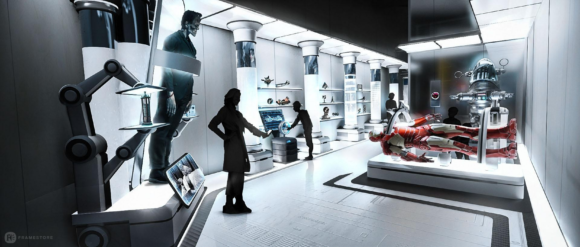Visiting Voyage to the Edge of Imagination at London’s Science Museum, 9 November 2022
London’s Science Museum has come up with a solution to the age-old problem of how to keep visitors from bunching up while they tour an exhibition. At an awkward corner of Science Fiction: Voyage to the edge of imagination, ALANN (for Algorithmic Artificial Neural Network) announces that all the air is about to leave the room (sorry: “deck”). To avoid the hard vacuum of outer space, please move along.
Little fillips of jeopardy enliven this whistle-stop tour of science, technology and imagination — not a show about science fiction (and in fact London’s had one of those quite recently: the Barbican’s superb 2017 Into the Unknown) so much as a show that does science fiction. The gallery is arranged as a story, which begins once a Pan Galactic Starlines shuttle drops us aboard a friendly if bemused alien craft, the Azimuth. The Azimuth’s resident AI is orbiting the Earth and pondering the curious nature of human progress, that puts imagination and storytelling ahead of practical action. It seems to ALANN — who jumps from screen to screen, keeping us company throughout — that using stories to imagine the future is a weirdly double-edged way of going about things. Humans could just as easily be steering towards nightmares, as toward happy outcomes. What will their future hold?
ALANN bottles it in the end, of course — our destiny turns out to be “uncomputable”. Oh for a show that had punters running screaming for the exits! Isn’t that what sf is for?
Assembled on a conspicuously low budget, and featuring mainly film props and costumes (which at the best of times never look that good in real life) and replicas (some of them jolly cheap), this “voyage to the edge of imagination” stands or falls by its wits. Next to a cheery video about trying to communicate with humpback whales as a rehearsal for alien “first contact”, some bright spark has placed a life-size xenomorph from the film Alien. Iron Man’s helmet is there to promote our eventual cyborgisation, melding metal and flesh to better handle the technological future — but so, mind you, is Darth Vader’s. The sheer lack of stuff here is disconcerting, but at the end of it all we have explored space, bent spacetime, communicated with aliens, and become posthuman, so clearly something is working. Imagine an excellent nest constructed from three sticks.
What this show might have achieved with a bigger budget is revealed in Glyn Morgan’s excellent accompanying book (Thames and Hudson, £30) featuring interviews with the likes of Charlie Jane Anders and Chen Qiufan.
This being the Science Museum, it’s hardly surprising that the exhibition’s final spaces are given over to pondering science fiction’s utility. Futurologist Brian David Johnson is on screen to explain how fiction can be used to prototype ideas in the real world. (Actual science fiction writers have a word for this: they call it “plagiarism”.) Whether you give credence to Johnson’s belief that sf is there to make the world a better place is a glass-half-full, glass-half-empty sort of question. “Applied science fiction” can be jolly crass. In a cabinet near Mr Johnson are a couple of copies of Marvel’s Captain Planet. In the 1990s, we are told, Captain Planet “empowered a new generation to be environmentally aware.” As someone who was there, I can promise you he jolly well didn’t.
But as I turned the next corner, the sneer still on my lips, I confronted as fine an example of imagination in action as you could wish for: Tilly Lockey, a couple of days off her seventeenth birthday, had been invited along to the press launch, and was skipping about like a dervish, taking photographs of her friend. In the gloom, I couldn’t quite see which bionic arms she was wearing — the ones based on the Deus Ex video game series, or the ones she’d received in 2019, designed by the team creating Alita: Battle Angel.
So that was me told.

